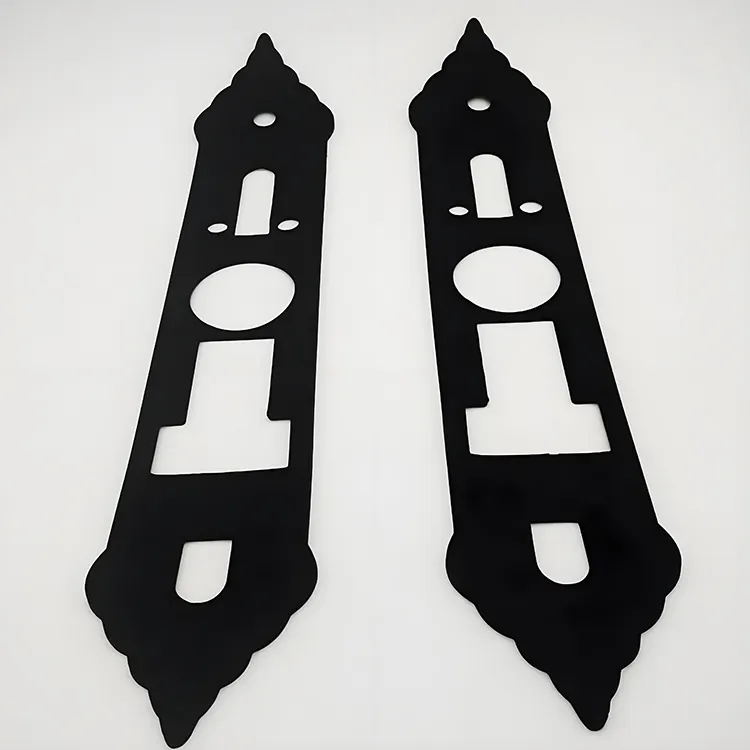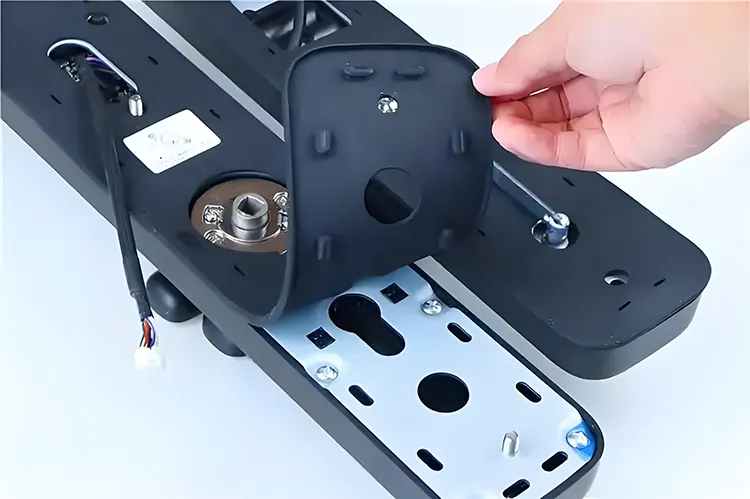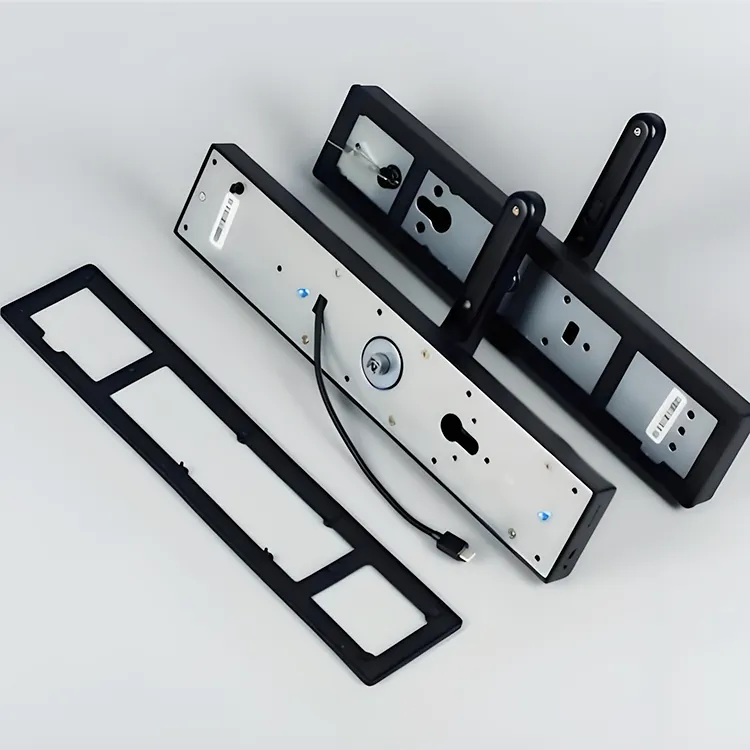Введение
На первый взгляд, умный дверной замок выглядит как элегантный образец современной техники, полный электроники, моторов и, возможно, даже сканера отпечатков пальцев. Но под этой поверхностью скрывается крошечный, часто упускаемый из виду компонент, который играет решающую роль в его долговременной надежности: замок. резиновая прокладка.
Эта статья написана для широкого круга читателей: будь то домовладелец, интересующийся вопросами долговечности, менеджер по продукции, контролирующий разработку замков, инженер, дорабатывающий спецификации продукции, или специалист по закупкам, выбирающий поставщиков. Я расскажу вам о том, как резиновые прокладки влияют на все - от повседневной работы до срока службы изделия.
Если вы когда-либо сталкивались с такими проблемами, как нестабильная герметичность, плохое прилегание или загадочные сбои в работе замков, скорее всего, это связано с конструкцией прокладки или ее отсутствием.
1. Важность резиновых прокладок в умных замках
1.1 Функциональные роли
При разработке или выборе умного замка большинство людей обращают внимание на такие характеристики, как радиус действия Bluetooth, время автономной работы или механическая прочность. Но за кулисами резиновые прокладки тихо обеспечивают функционирование этих функций в реальном мире.
Вот как:
- Герметизация от проникновения воды (защита IP)
Хорошо подогнанная резиновая прокладка образует водонепроницаемое уплотнение между корпусом замка и поверхностью двери. Это очень важно для достижения таких классов защиты, как IP65 или IP67, особенно при установке на улице. - Поглощение вибрации и ударов
Двери не являются статичными. Они хлопают, меняют температуру и вибрируют во время эксплуатации. Резиновые прокладки амортизируют эти движения, защищая чувствительную электронику и механические детали. - Компенсация неровностей поверхности
Не каждая дверь идеально ровная. Прокладки адаптируются к небольшим перекосам и дефектам, обеспечивая стабильную посадку без чрезмерного затягивания винтов. - Защита от пыли и насекомых
Плотно прилегающая прокладка не позволяет мелкой пыли, жучкам и частицам воздуха проникать во внутренние отсеки замка, что очень важно для его долгой работы. - Эстетичная отделка и устойчивость при монтаже
Прокладки также помогают создать ровный, профессиональный вид, сводя к минимуму дребезжание или несоосность между компонентами.
"Думайте о прокладке как о невидимой броне, защищающей ваш замок от внешнего мира - она работает, даже когда вы ее не видите".
1.2 Что может пойти не так?
Когда производители или монтажники пропускают или неправильно конфигурируют прокладку, проблемы проявляются быстро, а иногда и катастрофически.
- Повреждения, связанные с влажностью
В одном из случаев я столкнулся с умным замком, установленным на металлических воротах без прокладки. В течение шести месяцев печатная плата проржавела из-за попадания воды. Стоимость ремонта превысила стоимость всего замка. - Нестабильная посадка и несоосность замков
Без буферного слоя монтаж металла на металл или металла на дерево приводит к проблемам с выравниванием, особенно когда двери расширяются или сжимаются под воздействием влажности. - Попадание пыли и частое обслуживание
Даже замки, установленные внутри помещений, могут подвергаться ускоренному износу, когда пыль попадает на внутренние шестеренки и переключатели, что приводит к увеличению числа отказов и жалоб клиентов. - Уязвимость для несанкционированного доступа
Зазоры, образовавшиеся в результате плохой герметизации, могут стать слабыми местами, которыми злоумышленники воспользуются, чтобы поддеть или открыть замок силой.
Одним словом, резиновые прокладки - это не просто формальность, а неотъемлемая часть надежной конструкции умного замка.

2. Общие вопросы и заблуждения пользователей
2.1 Действительно ли необходима резиновая прокладка?
Этот вопрос я слышал чаще, чем могу сосчитать, особенно от домовладельцев или команд разработчиков продуктов с ограниченным бюджетом. Ответ зависит от условий, но чаще всего - нет, даРезиновая прокладка абсолютно необходима.
Многие пользователи недооценивают суровость реальных условий эксплуатации. Дождь, пыль, ультрафиолетовое излучение и тепловое расширение - это не только внешние проблемы, они влияют и на внутренние установки, особенно вблизи ванных комнат, кухонь или плохо закрытых входов.
Однако есть редкие случаи, когда уплотнитель может быть необязательным - например, в замках, используемых строго в сухих, контролируемых по температуре внутренних помещениях. Но даже в этом случае я видел, как прокладки обеспечивают долгосрочные преимущества, такие как шумопоглощение и эстетическая интеграция.
Итог: Если вы стремитесь к долговечности изделия, защите окружающей среды и сокращению числа обращений в сервисную службу, прокладка не является дополнительной - она необходима.
2.2 Влияет ли толщина прокладки на установку?
Безусловно. Одна из самых распространенных ошибок в дизайне - это завышение или занижение толщины прокладки.
- Слишком толстый:
Слишком толстые прокладки могут вызвать перекос крепления, что затруднит закрытие или правильное управление замком. Однажды я работал с командой, которая обнаружила, что их замки плохо подходят к узким стальным дверям, потому что 4-миллиметровая EPDM-прокладка вызывала наклон монтажной пластины. - Слишком тонкий:
Тонкие прокладки могут недостаточно сжиматься для создания эффективного уплотнения, особенно на неровных или текстурированных поверхностях, таких как двери из дерева.
Решение?
Определите стандартную толщину прокладки (например, 1,5 мм, 2,5 мм и 4 мм) для различных типов дверей или сотрудничайте с поставщиком, который может изготовить ее на заказ с учетом особенностей вашей монтажной поверхности.
2.3 Помешает ли он проводке или батарейному отсеку?
Хорошо спроектированная прокладка никогда не должна мешать работе электроники, но это случается, когда расположение прокладки не согласовано с внутренними компонентами.
В одном из проектов силиконовая прокладка случайно прижалась к жгуту проводов, медленно пережав кабель питания. Замок периодически терял питание, и потребовались недели поиска неисправностей, чтобы установить причину.
Чтобы избежать подобных неудачДизайнеры должны:
- Определите в CAD зоны зазора для прокладок
- Согласование с электрическими и механическими бригадами для прокладки проводов вдали от зон сжатия
- Используйте высечки, чтобы оставить отверстия вблизи чувствительных мест (например, крышек батарей или разъемов печатной платы).
"Прокладка должна обнимать конструкцию, а не душить систему. В хорошем дизайне защита сбалансирована с зазором".
3. Варианты материала резиновой прокладки
3.1 Распространенные материалы и их свойства
Выбор правильного материала для прокладок - это не только цена, но и соответствие физических свойств реальным условиям эксплуатации. Вот боковое сравнение материалов, обычно используемых в смарт-замках:
| Материал | Основные свойства | Рекомендуется для |
|---|---|---|
| Силиконовая резина | Высокая эластичность, отличный температурный диапазон (от -40°C до +200°C), устойчивость к озону, ультрафиолету и влаге | Уличные смарт-замки премиум-класса |
| EPDM | Доступная цена, хорошая устойчивость к ультрафиолетовому излучению и озону, умеренная температурная устойчивость (от -30°C до +120°C). | Бытовое применение |
| Пенополиуретан | Очень мягкая и сжимаемая, отлично подходит для неровных поверхностей, но менее устойчива к атмосферным воздействиям. | Внутренние замки или деревянные двери |
Силикон часто используется для элитных замков, которые должны выдерживать экстремальные температуры и воздействие, например, в прибрежных или пустынных районах.
EPDM обеспечивает баланс между долговечностью и стоимостью - идеальный вариант для моделей, предназначенных для массового рынка.
пенополиуретан полезен при установке замков на шероховатые или неровные поверхности, но его следует избегать в условиях повышенной влажности или ультрафиолетового излучения из-за его меньшей стойкости.
3.2 Устойчивость к огню, погодным условиям и старению
При выборе материалов, не полагайтесь на предположения - проверяйте данные. Надежные поставщики предоставляют технические паспорта (TDS), включающие:
- Диапазон температур
- Устойчивость к ультрафиолетовому излучению
- Степень огнестойкости (например, UL94 HB или V-0)
- Соответствие требованиям (RoHS, REACH, CA Prop 65)
Для замков, используемых в общественных зданиях, часто требуется соответствие стандартам огнестойкости. Всегда проверяйте сертификаты при выборе материалов.
3.3 Набор прочности при сжатии и долговечность
Способность прокладки восстанавливать свою первоначальную форму после многократного сжатия - известна как набор для сжатия-это очень важно для дверных конструкций.
Одним из стандартов, на который можно ссылаться, является ASTM D395В нем проверяется, насколько стойкая деформация возникает при контролируемом сжатии и нагреве.
Плохой набор компрессии приводит к:
- Ослабление уплотнения со временем
- Проникновение воды или пыли
- Повышенный износ деталей замка из-за движения
При ежедневном использовании двери открываются и закрываются сотни раз в месяц. Выбор материала с низкой степенью сжатия гарантирует сохранение эффективности уплотнения в течение длительного времени.
"Считайте долговечность годами, а не месяцами. Набор компрессии - это выносливость прокладки".

4. Проектные соображения для продуктовых команд
4.1 Форма, размер и расположение прокладок
Резиновые прокладки не являются универсальными. Форма, толщина и расположение должны соответствовать как корпусу замка, так и поверхности двери, чтобы обеспечить функциональность и эстетичность.
- Плоские и рельефные профили
Плоские прокладки просты и экономичны, но могут не обеспечивать достаточного отвода воды. Профили с приподнятыми краями или ребристые конструкции помогают отвести воду от уязвимых мест, улучшая гидроизоляционные характеристики. - Губы для дренажа
В некоторых элитных замках используется конструкция "манжетного уплотнения" - прокладки, слегка выступающей за периметр корпуса, чтобы направить сток воды и минимизировать ее скопление. - Сегментированные макеты
Разделение прокладки на функциональные сегменты позволяет не использовать одну полосу, а обеспечить более точную подгонку, снизить напряжение при сжатии и упростить монтаж.
Совет: Всегда подбирайте прокладку в соответствии с кривизной двери, глубиной защелки и геометрией корпуса замка. Неправильно подобранная форма приводит к образованию складок, зазоров или чрезмерному сжатию.
4.2 Интеграция в сборку изделия
Для эффективной сборки прокладки должны работать са не против вашего производственного процесса.
- Предварительно нанесенная клейкая основа
Клеи, чувствительные к давлению (PSA), помогают быстро разместить прокладки на корпусе или монтажной плате. Убедитесь, что используемый клей совместим как с материалом прокладки, так и с основой замка. - Формованные каналы для размещения
Многие замки премиум-класса имеют формованные канавки или пазы в пластиковой оболочке, которые фиксируют прокладку во время сборки. Это повышает повторяемость и снижает количество человеческих ошибок на линии. - Радиус углов и выравнивание отверстий
Убедитесь, что в конструкции прокладки учтены отверстия для винтов, зоны защелок и монтажные штифты. Используйте вырезы CAD или усиливающие кольца вокруг винтовых зон, чтобы предотвратить разрыв или сжатие.
4.3 Избегание ошибок при проектировании и установке
На собственном опыте я убедился, что эти три ошибки, которых можно избежать, приводят к реальным неудачам:
- Отсутствие направляющих для позиционирования
Сборщики могут перепутать прокладки даже на 1-2 мм, что приведет к нарушению герметичности. Добавьте в пластиковую оболочку выступы или формованные маркеры, чтобы зафиксировать прокладку в нужном положении. - Перекрывающиеся винты и область прокладок
Сжатие винтов непосредственно через прокладку может привести к неравномерному сжатию или разрыву. Всегда оставляйте зазоры или используйте шайбы. - Пренебрежение кабельными трассами
Прокладка проводов непосредственно под прокладкой без зон разгрузки может привести к повреждению от защемления. Предусмотрите зазоры в прокладке или более тонкие сегменты рядом с выходами кабелей.
"Умная прокладка - это та, которая незаметна в конструкции, но обеспечивает производительность в каждом цикле".
5. Что должны оценивать закупки
5.1 Требования к качеству и испытаниям материалов
Для команд, занимающихся закупками, важно не только получить лучшую цену, но и обеспечить надежную работу продукта в полевых условиях. Вот что я всегда рекомендую оценивать перед подтверждением заказа:
- Твердость по Шору А: Выберите степень твердости, соответствующую конструкции замка - обычно 30-60 единиц по Шору А для хорошего сжатия и долговечности.
- Прочность на разрыв: Выбирайте материалы с минимальным пределом прочности на разрыв 7 МПа для формованных прокладок и 5 МПа для губчатых.
- Испытание на сжатие (ASTM D395): Попросите предоставить документально подтвержденные результаты испытаний для обеспечения долгосрочной работы.
- Устойчивость к старению: Запросите результаты испытаний на ускоренное старение, например, данные о воздействии ультрафиолета, озона и высоких температур.
- Сертификация соответствия: RoHS, REACH, UL94 - несоблюдение этих требований может привести к задержке в получении разрешений на поставку продукции по всему миру или к отзыву продукции.
- Документация по рейтингу IP: Если вы покупаете замки в сборе, убедитесь, что требования IP66 или IP67 подтверждены сертифицированными протоколами испытаний, которые в значительной степени зависят от конструкции уплотнителя.
Контрольный список для оценки материала:
- Твердость и растяжение по Шору А
- Значения параметров сжатия (при ожидаемых условиях эксплуатации)
- Документация RoHS/REACH/UL
- Огнестойкость, если требуется (например, UL94 V-0).
- Технический паспорт поставщика (TDS)
5.2 Критерии выбора поставщика
При оценке поставщиков вам нужны не только спецификации материалов - вам нужна прозрачность партнерства.
Задайте эти ключевые вопросы:
- Могут ли они изменять размеры и профили?
Многие конструкции замков требуют нестандартных размеров или разъемных прокладок. Уточните, может ли поставщик предоставить нестандартные штампы или варианты лазерной резки. - Что такое MOQ (минимальное количество заказа)?
Некоторые поставщики формованных прокладок требуют высоких MOQ, в то время как экструдированные профили часто начинаются всего от 500 метров - то, на чем мы в KINSOE специализируемся. - Каковы сроки изготовления и поддержка прототипов?
Хороший поставщик должен предлагать образцы в течение 5-7 дней и предоставлять четкие сроки для масштабного производства. - Откуда берется материал?
Прозрачный выбор поставщиков помогает избежать отклонений в качестве или проблем с регулирующими органами в дальнейшем.
"Дешевый поставщик, который не может соответствовать спецификации, обходится дороже в долгосрочной перспективе".
5.3 Реальный случай: Отзыв продукции из-за неисправности прокладки
Один из заметных отзывов касался смарт-замка, который рекламировал защиту IP66, но использовал низкокачественную пенную прокладку. В течение нескольких месяцев поступали жалобы от потребителей: севшие батареи, заржавевшие внутренние детали и невозможность разблокировки во время дождя.
Расследование показало, что прокладка впитывала влагу, а не отталкивала ее, что привело к коррозии на плате управления. Компании пришлось отозвать более 20 000 устройств по всей Северной Америке.
Главный вывод: Всегда проверяйте поведение прокладки в реальных условиях, а не только в контролируемых лабораторных условиях.
Заключение
Поработав с бесчисленными командами разработчиков и увидев, как маленькие детали влияют на большие результаты, я могу с уверенностью сказать следующее: Резиновые прокладки - невоспетые герои надежности умных замков.
Хорошо продуманная прокладка защищает от воды, пыли и вибрации. Она обеспечивает плотное прилегание независимо от поверхности двери. Он снижает риск взлома и поддерживает ощущение первоклассного продукта. Но если на него не обращают внимания или он плохо подобран, он становится "ахиллесовой пятой" всей системы.
Неважно, выбираете ли вы замок для своей входной двери или являетесь менеджером по закупкам, подбирающим тысячи единиц товара, помните: Правильная прокладка - это не просто аксессуар, это необходимость.
Для покупателей B2B убедитесь, что материал, толщина и испытания поставщика прокладок соответствуют реальным требованиям. Дизайнерам и инженерам следует включать спецификации прокладок на ранних этапах проектирования в САПР. А производители - тестируйте, проверяйте и не срезайте углы при сжатии или устойчивости к воздействию окружающей среды.
Если вы занимаетесь разработкой или поиском интеллектуальных замков, не оставляйте выбор прокладки на волю случая. Протяните руку помощи обратитесь к своему поставщику как можно раньше-А если вам нужна квалифицированная поддержка, мы в KINSOE специализируются на изготовлении индивидуальных резиновых решений для электронных замков, от высокоэффективных силиконовых прокладок до экономичных профилей из EPDM.
Ссылки:

